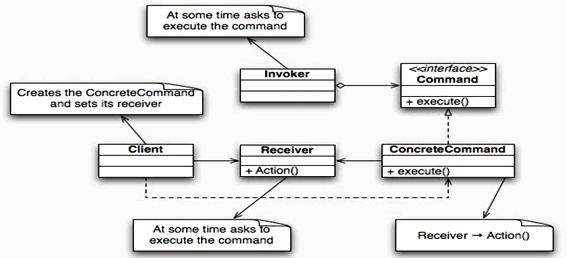命令模式
1. 什么是命令模式
Command 模武也叫命令模式,是行为设计模式的一种。Command 模式通过被称为 Command 的类封装了对目标对象的调用行为以及调用参数。
2. 命令模式的应用场景
在面向对象的程序设计中,一个对象调用另一个对象,一般情况下的调用过程是:创建目标对象实例;设置调用参数;调用目标对象的方法。
但在有些情况下有必要使用一个专门的类对这种调用过程加以封装,我们把这种专门的类称作 command 类。
- 整个调用过程比较繁杂,或者存在多处这种调用。这时,使用 Command 类对该调用加以封装,便于功能的再利用。
- 调用前后需要对调用参数进行某些处理。
- 调用前后需要进行某些额外处理,比如日志,缓存,记录历史操作等。
3. 命令模式的结构

4. 命令模式的角色与职责
- Command:Command 抽象类。
- ConcreteCommand:Command 的具体实现类。
- Receiver:需要被调用的目标对象。
- Invoker:通过 Invoker 执行 Command 对象。
5. 代码演示
5.1. 不使用命令模式
public class Peddler {public void sellApple() {System.out.println("卖苹果");}public void sellBanana() {System.out.println("卖香蕉");}}
Peddler peddler = new Peddler();peddler.sellApple();peddler.sellBanana();
5.2. Command
public abstract class Command {private Peddler peddler;public Command(Peddler peddler) {this.peddler = peddler;}public Peddler getPeddler() {return peddler;}public void setPeddler(Peddler peddler) {this.peddler = peddler;}public abstract void sell();}
public class AppleCommand extends Command {public AppleCommand(Peddler peddler) {super(peddler);}@Overridepublic void sell() {this.getPeddler().sellApple();}}
public class BananaCommand extends Command {public BananaCommand(Peddler peddler) {super(peddler);}@Overridepublic void sell() {this.getPeddler().sellBanana();}}
Peddler peddler = new Peddler();Command appleCommand = new AppleCommand(peddler);Command bananaCommand = new BananaCommand(peddler);appleCommand.sell();bananaCommand.sell();
5.3. Waiter
public class Waiter {private Command command;public Waiter() {}public Command getCommand() {return command;}public void setCommand(Command command) {this.command = command;}public void sell() {this.command.sell();}}
Peddler peddler = new Peddler();Command appleCommand = new AppleCommand(peddler);Command bananaCommand = new BananaCommand(peddler);Waiter waiter = new Waiter();waiter.setCommand(appleCommand);waiter.sell();waiter.setCommand(bananaCommand);waiter.sell();
5.4. 改进 Waiter
public class Waiter {private final List<Command> commands;public Waiter() {commands = new ArrayList<>();}public void addOrder(Command command) {this.commands.add(command);}public void removeOrder(Command command) {this.commands.remove(command);}public void sell() {for (Command command : commands) {command.sell();}}}
Peddler peddler = new Peddler();Command appleCommand = new AppleCommand(peddler);Command bananaCommand = new BananaCommand(peddler);Waiter waiter = new Waiter();waiter.addOrder(appleCommand);waiter.sell();System.out.println("==========");waiter.addOrder(bananaCommand);waiter.sell();System.out.println("==========");waiter.removeOrder(appleCommand);waiter.sell();
卖苹果==========卖苹果卖香蕉==========卖香蕉

